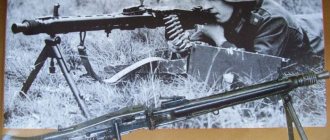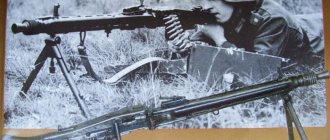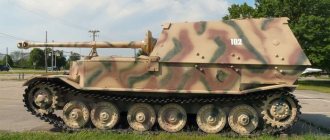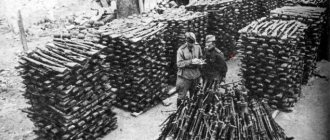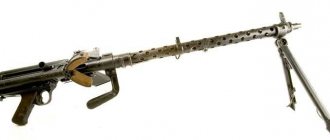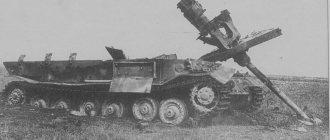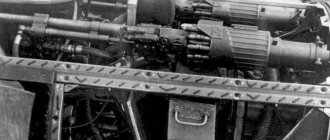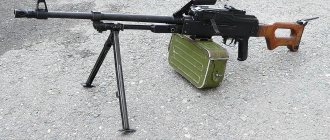More than seventy years have passed since the end of World War II - the most terrible conflict in human history. Few participants in those dramatic events remained alive, new generations were born and grew up, and the world has changed a lot. An opportunity has arisen for an impartial assessment of that era. Historians can methodically and seamlessly study the details of military operations, note the strengths and weaknesses of the opposing sides, evaluate tactics, and name the successful and unsuccessful decisions of commanders.
The same can be said about the weapons of World War II. Each of the opponents had successful design developments, as well as obvious mistakes. If we talk about the best machine gun of the Second World War, then it is, without a doubt, the German MG.42, which is an example of an excellent combination of reliability, efficiency and technological simplicity in production. It was so good that in a slightly improved form (MG.3) it still remains in service with the Bundeswehr.
Prospects for using the MG3 model
The MG3 machine gun was supposed to be gradually withdrawn from service and replaced by the MG5 by 2014. But thanks to its high rate of fire, reliability and unlimited adaptability to carriages, the MG3 still retains its permanent place in the army.
As an additional machine gun, the MG3 model remains in service with the Leopard 1 and Leopard 2 tank family, as well as the Marder infantry fighting vehicle, since the space in the fighting compartments of these armored vehicles does not allow mounting the MG5 without a comprehensive change in the mounting (carriage). The age of the weapon, combined with intensive use, leaves a clear mark on the material. First of all, the MG3 receiver often shows stress-related cracks that cannot be repaired further. Attempts to purchase replacement receivers on the world market that meet Bundeswehr quality standards ultimately failed.
According to a number of Western experts, it is likely that the knowledge of sheet metal stamping technology for this part has been lost in recent decades. Its updating, but only in a new specification, is possible only for a large series of products. The latter would become economically justified with investments in appropriate production facilities. However, due to the wide distribution of the successor model, the MG5 model, such a scenario is excluded.
MG3A0A1 machine gun on a bipod
To maintain the functionality of the existing arsenal of modern MG3 machine guns until the end of their useful life, it was necessary to resort to an unconventional approach. In particular, the Rheinmetall concern received an order for milled receivers to cover the remaining needs. MG3 machine guns with these new receivers were designated MG3 A0A1 or MG3 A1A1.
As experts point out, the irony is that the success of the MG42 was due to the introduction of sheet metal stamping technology. Now it is possible to keep the MG3 in operation only by abandoning this production technology.
Anti-pancake tape
Let's move on to the most sore point - feeding with ammunition. For the MG-34 there were 75-round magazines, 250-round and 50-round magazines. The best option was, perhaps, a store, but it did not gain much popularity. A 250-round belt is terribly inconvenient to carry around, so the most popular option has become a 50-round belt.
It was good for almost everyone, except for one thing: since the tape was not loose, as the ammunition was used up, an increasingly long, useless piece dangled near the machine gun. Why the Germans didn’t think of putting the tape in a box, as they did later on most machine guns, is not very clear - the solution is on the surface.
The magazine for the Degtyarev machine gun is probably the most unfortunate part of the weapon. The famous “pancake”, which made the silhouette of the Soviet machine gun so recognizable, looked beautiful and fed cartridges relatively smoothly. But it had a colossal “dead weight”: even without cartridges, the disk magazine pulled 1.6 kg, and with 47 cartridges - as much as 2.7 kg.
Photo: wikipedia.org
For comparison: box magazines for modern “Degtyarev” light machine guns weighed 300-400 g empty and a maximum of 1 kg loaded with a capacity of 20-30 rounds. A special bag was required to carry multiple magazines. And the “pancake” attached to the top of the machine gun forced the shooter to raise his head a little higher to see the enemy. That is, to unmask yourself a little more with the risk of death.
Of course, in the USSR they understood this and tried very hard to make a more practical magazine for the machine gun - for example, a “horn” on top, like the Czech ZB-26 or its British clone Bren. But it never worked out to make something decent for the outdated 7.62×54 cartridge with a rim. Soviet industry did not pull powerful enough springs - and the good idea had to be abandoned. But no good metal belts were developed in the USSR at all - the easel “Maxim” used archaic canvas, which was poorly suited for light machine guns. The result was not an optimal store, but a “poor man’s option.”
Photo: joyreactor.cc
Which is better - tape or disk magazine? History has put everything in its place. Almost all Kalashnikov machine guns and most of their foreign counterparts use tape. The disk magazine on top is used only in the Degtyarev machine guns themselves and their Chinese clones. And in the world history of weapons there are only a few models of such stores: for example, the famous English “Lewis”. And the immediate successor to the DP, the RPD, already used tape in the box. True, it was not created for a cartridge with a rim, but the trend is clearly visible - the “damn” was definitely a worse solution than the tape.
Usually, the advantage of the Degtyarev machine gun is its manufacturability and low cost - the weapon could be produced by not particularly qualified personnel, while the MG-34 was quite complex and expensive. But in this case, the situation turns out to be approximately the same as with a disk magazine - the fact that the USSR did not pull off others does not make this design better. This argument would be logical if, due to its complexity, the “Maschinengever” was produced in a critically small quantity. However, this is not so: both the DP and the MG-34 were produced in quantities of about a million. Therefore, the “order beats class” option does not work here.
Chinese machine gun "Type 53", DP clone. Photo: wikipedia.org
Modifications
T24
The US military attempted to copy the MG 42 during the war as a possible replacement for the Browning Automatic Rifle and M1919A4 in infantry units. The T24 version was designed to use the .30-06 cartridge. A working prototype was built under the symbol T24. It could be used on the M2 machine. Due to the fact that the American .30-06 cartridge turned out to be too long for a single machine gun, as well as due to the design flaws of the prototype - disgusting accuracy and short effective firing range - the project was canceled.
MG3
Main article: MG3
MG3
A modern version of the MG 42 is the MG3 machine gun, manufactured by Rheinmetall AG. It is in service with the Bundeswehr and is widely exported to various countries. It is also produced under license in Greece, Pakistan, Spain and Turkey. It is distinguished by the same high rate of fire as its predecessor. The rate of fire in bursts can be adjusted by various bolts: the lighter the bolt, the higher the machine gun’s rate of fire. Although the machine gun prototype was released more than 70 years ago, the MGZ remains a highly effective weapon. The problem with using this machine gun is the need to change the barrel at a very high rate of fire. Even when firing in short bursts, with the rate of fire increasing to 1250 rounds per minute, the shooter must change the barrel after 150 rounds or every 36 seconds.
Zastava M53
Main article: Zastava M53
Zastava M53
Yugoslavia created the M53 based on the MG 42 using a reverse engineering method, retaining the old German caliber chambered for 7.92x57 mm. The Yugoslavs tried to preserve the original design of the machine gun, so the M53 is almost no different from the original. The main difference is only in the reduced rate of fire. Otherwise, the characteristics of the machine gun are the same as those of the MG 42. Those MG 42s that were captured at the end of World War II were introduced into the reserve of the Yugoslav People's Army as the M53/42. Many M53s were sold to Iraq and saw service in both Gulf Wars. In Yugoslavia itself, M53 machine guns were last used by the military in 1999. The machine gun also bore the designation “Sharac” (Serbian Sharac / Šarac).
Steyr MG-74
MG 74
The latest in the series of MG 42 variants is the Austrian MG-74, which has been the standard single machine gun in the Austrian armed forces since 1974.
After its founding in 1955, the Austrian army was equipped with obsolete American Browning M1919 machine guns. Beginning in 1959, Browning machine guns were gradually replaced by the German MG 42/59 (MG 1A2) chambered for the standard NATO cartridge - 7.62x51 mm.
However, the Bureau of Defense Technology, in collaboration with Steyr Mannlicher and Beretta, developed a machine gun specifically for the Austrian army. The modified German MG 42/59 (which also became the basis for the MG3) chambered for NATO served as the basis for the creation of our own single machine gun. Development of the modified machine gun was completed in 1974.
Design changes include a heavier bolt: 950 grams versus 675 grams for the MG3 bolt, reducing the rate of fire to 900 rounds per minute. Added a switch for single-fire capability. The MG-74 has a dark green polymer grip and stock, an adjustable rear sight (35° horizontal, 15° vertical) and can be equipped with an additional anti-aircraft sight.
Trace in culture
The Second World War was widely reflected in artistic culture. The image of the German soldier trying to conquer the world for his Fuhrer is known in all corners of the Earth.
Not a single serious film or book could ignore the topic of MG-42.
The merciless “saw”, firing at both soldiers going on the attack and civilians, is found in hundreds of artistic descriptions of the past war.
If you remove emotions, you will be left with an excellent example of weapons, a machine gun, which served as the progenitor of the direction of single machine guns, which is used to this day.
Design
Roller shutter system MG 42/MG 3
The MG 42 was developed to meet very specific requirements: it had to be a single machine gun, as cheap as possible to produce, as reliable as possible and with high firepower - up to 20-25 rounds per second or more, achieved by a relatively high rate of fire. Although the MG 42 design used some parts from the MG 34 machine gun (which eased the transition to the production of a new model of machine gun in war conditions), overall it is an original system with high combat performance. Higher manufacturability of the machine gun was achieved thanks to the widespread use of stamping and spot welding: The box and barrel casing were made by stamping from a single blank, whereas for the MG 34 these were two separate parts made on milling machines. For the purpose of simplification, they abandoned the possibility of feeding the tape from either side of the weapon, the possibility of magazine feed and the fire mode switch. As a result, the number of parts was reduced to 200. As a result, the cost of the MG 42 compared to the MG 34 was reduced by about 30% (the MG 34 machine gun cost the Wehrmacht 300 marks), and the metal consumption by 50%.
Principle of operation
Various versions of the MG 42
German paratrooper from the 11th Air Corps (French) Russian. with MG 42 and tape for it (1943)
The MG 42 machine gun operates on the recoil principle (short stroke). It consists of the following main parts and mechanisms: a barrel with a casing box; bipod; butt plate with butt; shutter; locking, feeding, impact and trigger mechanisms. The bolt is locked using rollers (lugs), which move apart. The rollers are located in the combat cylinder and are moved apart when locked by the bevels of the wedge, and when unlocked they are brought together by the bevels of the box. The striker-type impact mechanism is located in the bolt. It consists of a striker and a striker. The role of the mainspring is performed by the return spring. The trigger mechanism is located in the fire control handle and allows only continuous fire. When firing, the machine gun is fed with cartridges from a flexible metal belt with a semi-closed link, one with the belt of the MG 34 machine gun. One belt can be attached to another using a cartridge, due to which the length of the loaded belt can be increased.
Barrel cooling
As with the MG 34 machine gun, the problem of barrel overheating during prolonged shooting was solved by replacing it. The barrel was released by snapping a special clamp. Changing the barrel required from 20 to 30 seconds, depending on the experience of the machine gunner, and one free hand, as a result of which it did not lead to delays in battle.
Technical characteristics of MG.42/43
| Performance characteristics | ||
| Name | MG.42 | MG.3 |
| Caliber, mm | 7,62 | 7,62 |
| Overall length, mm | 1230 | 1225 |
| Barrel length, mm | 530 | 565 |
| Total weight, kg | 11,6 | 11,05 |
| Rate of fire, rds/min | 1200-1300 | 900-1300 |
| Beginning bullet speed, m/s | 710 | 820 |
| Prix. range, m | 2000 | 1200 |
Story
By the beginning of World War II, the Wehrmacht had as a single machine gun the MG 34, created in the early 1930s. For all its advantages, it had two serious drawbacks: firstly, it turned out to be very demanding on the operator’s skills and the quality of ammunition; secondly, it was extremely labor-intensive and expensive to produce, which did not make it possible to satisfy the ever-increasing needs of the troops for machine guns.
The MG 42 was created in the little-known town of Döbeln (German: Metall-und Lackwarenfabrik Johannes Großfuß). Authors of the design: Werner Gruner
) and Kurt Horn (
Kurth Horn
). Adopted by the Wehrmacht in 1942. The machine gun was put into production at the Grosfus plant itself, as well as at the Mauser-Werke, Gustloff-Werke and other factories. Production of the MG 42 continued in Germany until the end of the war, with a total production of at least 400,000 machine guns. At the same time, the production of the MG 34, despite its shortcomings, was not completely curtailed, since, due to some design features (rear barrel change, the ability to feed tape from either side), it was better suited than the MG 42 for installation on tanks and in other combat vehicles.
Other weapon features and interesting facts
Since the MG-42 was a single machine gun, it could be fired both from a bipod and from a special machine. This expanded the range of tasks and possibilities for using weapons.
Weapon standards adopted in 1944 prescribed that an infantry regiment should be armed with 118 MG-42 machine guns of the manual version, and 24 of the easel version. When used manually, it was possible to shoot at a distance of up to 800 meters. The mounted version assumed the use of a unified infantry mounting of the 1942 model; it had MGZ-34 and MGZ-40 (optical) sights. But the machine gun was used not only in the infantry. A way was developed to install it on a tank (both in a turret on the turret and in the internal space), an armored personnel carrier, an aircraft (mainly installed on bombers as a gunner’s weapon). That is, the concept of a single machine gun has grown into even more than could have been expected from it initially.
From the moment it was put into service, the machine gun was produced until the very end of World War II. According to available data, a total of about 350 thousand units of these weapons were produced.
German engineers did not stop at a single version of the machine gun. Work was carried out to modernize it, as a result of which the so-called MG-42 (B), or MG-45, appeared. It weighed 6.5 kg, and the already high rate of fire increased to a record at that time - 2400 rounds per minute. No machine gun existing in the world had such a rate of fire. But the MG-45 appeared too late and was not in service with the Wehrmacht.
History of the creation of the MG.42 machine gun
In the twentieth century, war became a real competition of technology. This trend was clearly reflected in the development of small arms, which changed beyond recognition over the first fifty years of the century.
The machine gun (in its modern sense) first appeared at the end of the 19th century, and the first experience of use showed the high effectiveness of this type of weapon. But the real finest hour of the machine gun was the First World War. Machine guns were installed on tanks, airplanes, and warships. Most machine guns of that time had a decent weight, they were installed on special machines or turrets. It was mainly a defensive weapon. At the end of the war, the first heavy machine gun (13.35 mm) was created.
During the period between the world wars, a large number of very successful examples of such weapons appeared: the Vickers machine gun (Great Britain), Browning (USA), ShKAS and DShK (USSR). All these machine guns subsequently took an active part in the Second World War.
Here are their comparative characteristics:
| Characteristics | Light machine guns | Heavy machine guns | ||||
| Machine gun | MG.42 | “Bran” Mk1 | DP-27 | MG.42 | М1919А4 | SG-43 |
| A country | Germany | England | USSR | Germany | USA | USSR |
| Cartridge | 7,92×57 | 7,7×56 (.303) | 7.62x53R | 7,92×57 | 7,62×63 | 7.62x53R |
| Weight of weapon with cartridges, kg | 12,6 | 11,5 | 10,6 | 32,1 | 21,55 | 40,4 |
| Machine gun body length, mm | 1219 | 1150 | 1272 | 1219 | 1041 | 1150 |
| Initial bullet speed, m/s | 750 | 745 | 840 | 750 | 853 | 865 |
| Rate of fire, rds/min | 1200 | 660 | 600 | 1200 | 500 | 500-700 |
| Magazine (tape) capacity, cartridges | 50 | 30 | 47 | 250 | 250 | 250 |
Work was actively carried out on the creation of a so-called single machine gun, which could perform the functions of both a light infantry machine gun and a turret, mounted, or mounted on armored vehicles.
This concept significantly simplified the use of the machine gun and reduced the cost of supplying and training personnel. A similar issue was dealt with in many countries of the world, but they were able to achieve success only in Germany.
The German MG.34 is considered the first single machine gun. It was created by Rheinmetall AG; during its development, all the experience of using similar weapons in the First World War was taken into account. It could be used from a bipod, used as an easel, aircraft, or installed in tanks and other armored vehicles. The machine gun weighed only 12 kg (for comparison, the weight of the Maxim machine gun is 60 kg), so it could be carried and could perfectly support units at the front line with fire.
The machine gun had many advantages (it continued to be produced until the very end of the war), but there were also disadvantages.
The main problem of the MG.34 was its high cost and rather complex design. It had a large number of milled parts that required special types of steel. The cost of one machine gun was 327 Reichsmarks, which was very expensive for that time. Disassembling the machine gun and servicing it was quite difficult. For this reason, the decision was made to modernize the machine gun, and it began in 1938. The outbreak of hostilities in Russia only accelerated this process: the MG.34 was very sensitive to pollution, which had an unpleasant effect during its use on the Eastern Front and in the sands of North Africa.
The victory in the competition for the best machine gun upgrade was won by the little-known company Metall und Lackierwarenfabrik Johannes Grossfuss AG, which had not previously dealt with small arms at all. After the improved MG.42 model was adopted, its production began not only at the plant of the development company, but also at other German factories.
At the end of 1941, the first machine guns of the MG.42 version were sent to the Eastern Front for field testing, and in 1942 this model was adopted by all branches of the German military.
The MG.42 can easily be called a wartime weapon because it was much simpler than the MG.34. The machine gun had a large number of stamped parts, which significantly reduced the complexity of its manufacture and cost. Wherever possible, riveted and screw connections were replaced by spot welding. Even a not very skilled worker could produce such weapons. The wooden stock was replaced with a plastic one.
At the same time, simplification did not have a detrimental effect on the efficiency of MG.42. Quite the contrary: the new machine gun turned out to be more reliable and resistant to contamination.
It could be used as an easel, as well as fired from a bipod, mounted on military equipment, and used as an anti-aircraft machine gun. MG.34 and MG.42 are very difficult to distinguish by appearance; the “thirty-four” can be recognized by its characteristic round barrel casing. On the MG.42 it is angular and stamped.
After the first captured MG.42 appeared in the USSR, Soviet intelligence made the incorrect conclusion that Germany was running out of resources, and therefore the Germans had to produce such weapons. Germany really didn’t have very good resources, but in this case there was an absolutely conscious decision to make weapons cheaper.
Production of the MG.42 continued until the very end of the war, with a total of approximately 400 thousand copies produced. At the same time, production of the MG 34 was going on, because it was better suited for installation on military equipment.
In 1944, work was underway in Germany to simplify and reduce the cost of the MG.42. The new modification of the machine gun had a fixed barrel and a semi-free bolt. Even low-grade steel could be used to make new weapons, which was very important for Germany at the final stage of the war. German designers managed to reduce the weight of the machine gun to 6.5 kg, that is, even one soldier could easily handle it. This machine gun was named MG.45, but it was never put into mass production. The MG.45 had an even higher rate of fire: 2400 rounds per minute. Many developments from this design were later used to develop post-war weapons.
At the end of the fifties, the MG.42 was put into service under the designation MG.3. It was chambered for 7.62x51 mm. To do this, the barrel and some other elements of the weapon had to be replaced, and numerous small improvements were also made. Due to its high combat characteristics and manufacturability, this machine gun is still actively exported and produced under license in several countries.
